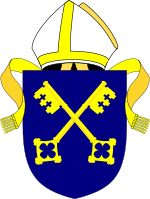Gloucester Cathedral, formally the Cathedral Church of St Peter and the Holy and Indivisible Trinity, in Gloucester, England, stands in the north of the city near the River Severn. It originated with the establishment of a minster, Gloucester Abbey, dedicated to Saint Peter and founded by Osric, King of the Hwicce, in around 679. The subsequent history of the church is complex; Osric's foundation came under the control of the Benedictine Order at the beginning of the 11th century and in around 1058, Ealdred, Bishop of Worcester, established a new abbey "a little further from the place where it had stood". The abbey appears not to have been an initial success, by 1072, the number of attendant monks had reduced to two. The present building was begun by Abbott Serlo in about 1089, following a major fire the previous year.
Serlo's efforts transformed the abbey's fortunes; rising revenues and royal patronage enabled the construction of a major church. William the Conqueror held his Christmas Court at the chapter house in 1085, at which he ordered the compilation of Domesday Book. In October 1216, Henry III was crowned at the abbey. Following another disastrous fire in 1222, an ambitious rebuilding programme was begun. In the 14th century, the Great and Little Cloisters were constructed, displaying the earliest, and perhaps the finest, examples of fan vaulting anywhere. The cathedral contains the shrine of Edward II, who was murdered at Berkeley Castle nearby.
Following the dissolution of the monasteries by Henry VIII in 1536, the abbey was refounded as a cathedral. The cathedral underwent much restoration in the 18th century, and again in the 19th. In 1989, it celebrated its 900th anniversary. In 2015, the installation of Rachel Treweek saw the Church of England appoint its first woman as a diocesan bishop. The cathedral has frequently been used as a filming location, including as a stand-in for Hogwarts in the Harry Potter movies.
The cathedral is a Grade I listed building. There are a large number of other listed buildings within the cathedral complex, many also listed at Grade I, the highest grade. These include the Treasury, the Chapter House, the Cloisters, the precinct wall and a number of the medieval gates into the cathedral enclosure. Others are listed at Grade II* and Grade II.












